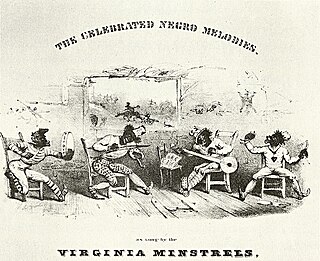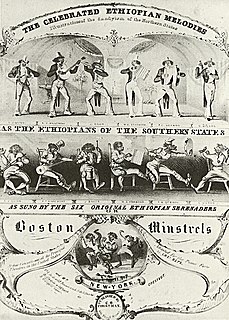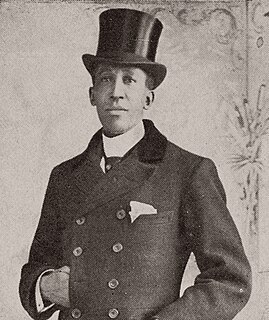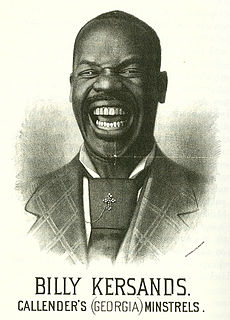
The minstrel show, or minstrelsy, was an American form of racist entertainment developed in the early 19th century. Each show consisted of comic skits, variety acts, dancing, and music performances that depicted people specifically of African descent. The shows were performed by mostly white people in make-up or blackface for the purpose of playing the role of black people. There were also some African-American performers and black-only minstrel groups that formed and toured. Minstrel shows lampooned black people as dim-witted, lazy, buffoonish, superstitious, and happy-go-lucky.

Master Juba was an African-American dancer active in the 1840s. He was one of the first black performers in the United States to play onstage for white audiences and the only one of the era to tour with a white minstrel group. His real name was believed to be William Henry Lane, and he was also known as "Boz's Juba" following Dickens's graphic description of him in American Notes.

"Dixie", also known as "Dixie's Land", "I Wish I Was in Dixie", and other titles, is a song about the Southern United States first made in the mid-19th century. It is one of the most distinctively Southern musical products of the 19th century and probably the best-known song to have come out of blackface minstrelsy. It was not a folk song at its creation, but it has since entered the American folk vernacular. The song likely cemented the word "Dixie" in the American vocabulary as a nickname for the Southern U.S.

Thomas Dilverd was said to be of Native American and African American ancestry. His professional name was Japanese Tommy, and he performed in blackface minstrel shows. He was also sometimes billed as "The African 'Tom Thumb'" and the "African Dwarf Tommy".

The Ethiopian Serenaders was an American blackface minstrel troupe successful in the 1840s and 1850s. Through various line-ups they were managed and directed by James A. Dumbolton (c.1808–?), and are sometimes mentioned as the Boston Minstrels, Dumbolton Company or Dumbolton's Serenaders.

Christopher Haverly (1837–1901), better known as J. H. Haverly or John H. "Jack" Haverly, was an American theatre manager and promoter of blackface minstrel shows. During the 1870s and 1880s, he created an entertainment empire centered on his minstrel troupes, particularly Haverly's United Mastodon Minstrels and Haverly's Colored Minstrels. Under his guidance, these troupes grew to impressive sizes and featured elaborate sets and costumes. They toured widely, enlarging minstrelsy's audience to encompass the entire United States as well as England. Haverly's methods sparked a revolution in minstrelsy as other troupes scrambled to compete. As the costs of minstrelsy increased, many troupes went out of business.

Sam Lucas was an American actor, comedian, singer, and songwriter. Sam Lucas's exact date of birth is disputed. Lucas's year of birth, to freed former slaves, has also been cited as 1839, 1840, 1841, and 1850.

Billy Kersands was an African-American comedian and dancer. He was the most popular black comedian of his day, best known for his work in blackface minstrelsy. In addition to his skillful acrobatics, dancing, singing, and instrument playing, Kersands was renowned for his comic routines involving his large mouth, which he could contort comically or fill with objects such as billiard balls or saucers. His stage persona was that of the dim-witted black man of the type that had been popularized in white minstrel shows. Modern commentators such as Mel Watkins cite him as one of the earliest black entertainers to have faced the dilemma of striking a balance between social satire and the reinforcement of negative stereotypes.
Wallace King was an African American blackface minstrel performer from the 19th century. He played with Callender's Georgia Minstrels, and in 1882 was second to only Billy Kersands in pay and popularity. King was a "Sweet Singing Tenor" and known for his emotional, romantic ballads.
Charles Callender was the owner of blackface minstrel troupes that featured African American performers. Although a tavern owner by trade, he entered show business in 1872 when he purchased Sam Hague's Slave Troupe of Georgia Minstrels.
Sam Hague was a British blackface minstrel dancer and troupe owner. He was a pioneering white owner of a minstrel troupe composed of black members, and the success he saw with this troupe inspired many other white minstrel managers to tour with black companies.

Primrose and West was an American blackface song-and-dance team made up of partners George Primrose and William H. "Billy" West. They later went into the business of minstrel troupe ownership with a refined, high-class approach that signaled the final stage in the development of minstrelsy as a distinct form of entertainment.
Bob Height was an American 19th century African-American blackface minstrel performer. He was a standout talent in the companies with which he performed, although frustrations eventually drove him to pursue a career in Europe. Later writers have compared him to his contemporary, Bert Williams.

Butterbeans and Susie were an American comedy duo comprising Jodie Edwards and Susie Edwards. They married in 1917, and performed together until the early 1960s. Their act, a combination of marital quarrels, comic dances, and racy singing, proved popular on the Theatre Owners Booking Association (TOBA) tour. They later moved to vaudeville and appeared for a time with the blackface minstrel troupe the Rabbit's Foot Company.

Gustave Frohman was a theatre producer and advance man. He was one of three Frohman brothers who entered show business and he worked for most of his career alongside his brother, Charles Frohman. These two financed a number of theatre productions, often featuring African American actors. For instance, in 1878, they starred Sam Lucas in the first serious stage production of Uncle Tom's Cabin with a black man in the lead role.
Charles Barney Hicks was an American advance man, manager, performer, and owner of blackface minstrel troupes composed of African-American performers. Hicks himself was a minstrel performer who could sing and play challenging roles such as the minstrel-show interlocutor or endmen. However, he was most interested in the business side of minstrelsy. Over the course of his career, he worked with most successful black minstrel troupes as manager, owner or both. The white-dominated minstrel market proved hostile to a black owner, and Hicks had to travel abroad or manage for white owners in order to make a reliable living. Nevertheless, both white and black rivals came to respect him. One observer in 1891 wrote, "This man Hicks was a dangerous man to all outside managers and they all were afraid of him." In 1912, Hicks was the sole African American listed on M. B. Leavitt's list of "best known advance agents during the last fifty years".

Lew Johnson was an African-American owner and business manager of blackface minstrel troupes composed of African-American performers. His career began in the mid-1860s and spanned 25 years. Johnson is the only black minstrel-troupe owner to have enjoyed any consistent success. This was due to his keeping well away from the lucrative markets dominated by white owners. He primarily toured in the Midwestern and Western United States, playing countless one-nighters in rural settlements. The people in these areas could be racist, which made the itinerant lifestyle a hard one for Johnson and his minstrels. Johnson made a brief venture into the Eastern market in 1886, but his troupe fared poorly and fled back west.
Bryant's Minstrels was a blackface minstrel troupe that performed in the mid-19th century, primarily in New York City. The troupe was led by the O'Neill brothers from upstate New York, who took the stage name Bryant.
The stump speech was a comic monologue from blackface minstrelsy. A typical stump speech consisted of malapropisms, nonsense sentences, and puns delivered in a parodied version of Black Vernacular English. The stump speaker wore blackface makeup and moved about like a clown. Topics varied from pure nonsense to parodies of politics, science, and social issues. Although both the topic itself and the black character's inability to comprehend it served as sources of comedy to white people, minstrels used such speeches to deliver racist social commentary. The stump speech was a precursor to modern stand-up comedy.
"Miss Lucy Long", also known as "Lucy Long" as well as by other variants, is an American song that was popularized in the blackface minstrel show.












